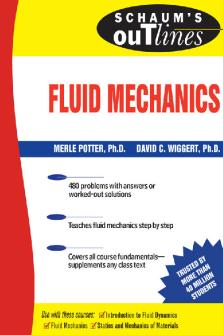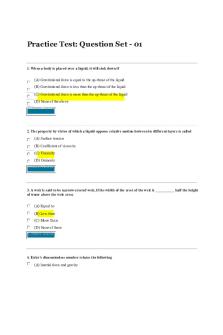ENG1062 Fluid Mechanics and Thermodynamics 1 2016-17 PDF

| Title | ENG1062 Fluid Mechanics and Thermodynamics 1 2016-17 |
|---|---|
| Course | FLUID MECHANICS & THERMODYNAMICS 1 |
| Institution | University of Surrey |
| Pages | 9 |
| File Size | 431.5 KB |
| File Type | |
| Total Downloads | 112 |
| Total Views | 142 |
Summary
Past paper for ENG1062 Fluid Mechanics and Thermodynamics 1 Semester 1 2016-17...
Description
ENG1062/Sem 1 2016-17/pp9 (1 handout)
UNIVERSITY OF SURREY© Faculty of Engineering & Physical Sciences Department of Mechanical Engineering Sciences Undergraduate Programmes in Mechanical, Medical, Aerospace, Automotive & Chemical Engineering.
Module ENG1062; 15 Credits FLUID MECHANICS & THERMODYNAMICS 1 FHEQ Level 4 (Year 1) Time allowed: Two hours
Semester 1 2016/17
Use separate answer books for sections A and B Answer ALL questions
Where appropriate the mark carried by an individual part of a question is indicated in square brackets [ ]. Calculator restrictions: Casio Models FX115MS, FX115W or FX115S, or other models with lower functionality
Additional materials: Thermodynamic and Transport Properties of Fluids by Rogers & Mayhew (5th edition) are provided. 1 HANDOUT: Pump Characteristics FIG A3(c).
© Please note that this exam paper is copyright of the University of Surrey and may not be reproduced, republished or redistributed without written permission
ENG1062/Sem 1 2015-16/pp9 (1 handout)
EQUATION SHEET (standard notation is used) FLUID MECHANICS Ideal Gas pV mRT nR0 T
nRT dU
Newtonian Law of viscosity (laminar flow) dp dz
Hydrostatic equation
g gV
Buoyancy Force FB
UL
Reynolds Number ReL mass flow-rate m
AUm
Bernoulli Equation p
1 2
U2
Discharge coefficient CD = Fluid Power
V
Fluid Momentum
dy
gz
constant along a streamlin
true volume flow-rate ideal volume flow-rate
p
åF å m U o
å
o
outlets
CV
miUi
inlets
w
Friction coefficient Cf
U2 m
1 2
Pressure drop in a pipe-line due to friction
p
1 2
U2mC 4L f D
THERMODYNAMICS W pdV
ò
For a polytropic process (pV n
constant) W
Closed system : Q
E
W
For a liquid or solid, sensible heat
Wnet Qin
Thermal efficiency : WS
mC
T
Qin
m h2
12
2
c2
Qout Qin
gz 2
h1
1 2
cv
æ duö çè dT ÷ø V
cp
For reversible adiabatic processes:
2
gz1
c1
Specific enthalpy in a mixture region h hf For ideal gases:
(without change of phase
åQ åW
For a cyclic process :
SFEE : Q
Q
p2 V2 p1V1 1 n
xhfg in a liquid h hf @ T
æ dhö çè dT ÷ø P pV
C
cp TV
cv 1
R C
Tp(
1) /
where C is a constant 2
[SEE NEXT PAGE]
ENG1062/Sem 1 2015-16/pp9 (1 handout)
SECTION A - FLUID MECHANICS [66 marks guide time: 80 minutes] A1. (a)
Define all of the variables in the equation for the Newtonian Law of viscosity. Give one example of … (i) a Newtonian fluid (ii) a shear thinning fluid (iii) a shear thickening fluid [6]
(b)
The Moody diagram sketched below in Fig A1(b) is used to describe the effects of internal pipe roughness on the flow in a circular pipe. Reproduce the diagram below and on it label the axes 1, 2 and 3 and describe what the regions A and B correspond to. [6]
Fig A1(b)
3
[SEE NEXT PAGE]
ENG1062/Sem 1 2015-16/pp9 (1 handout)
(c)
For the horizontal contraction shown in Fig A1(c) …
Fig A1(c) (i) (ii)
(d)
sketch a suitable control volume, clearly indicating all the forces, derive a simple equation to estimate the force on the contraction Fx using only the variables shown. Note 𝑉 denotes the volumetric flow-rate, the fluid density, and A is the pipe cross-sectional area. [6]
Define with the aid of a sketch the meta-centre for a cargo ship of the type shown in Fig A1(d).
Fig A1(d) Where must the meta-centre lie in relation to the centre of gravity of the vessel for stability in roll? If the sea-water has density 1027 kg/m3 and the displacement of the ship is 3000 m3, what is the weight of the ship? [6] (e)
In terms of base dimensions M (for mass), L (for length) and T (for time) show the base dimensions for the following quantities: (i) pressure (ii) energy (iii) surface tension [6] [TOTAL 30] 4
[SEE NEXT PAGE]
ENG1062/Sem 1 2015-16/pp9 (1 handout)
A2. Water of density =1000 kg/m3 flows through a vertical venturi meter, which is connected to a manometer as shown in Fig A2. The manometer uses mercury of density m= 13600 kg/m3 as the manometric fluid.
Fig A2 (a)
Apply the Bernoulli equation to the flow through the meter and indicate on a sketch the streamline used and the points selected for analysis. [4]
(b)
Using the manometer data calculate the difference in pressure between the 2 measuring points on the venturi. [5]
(c)
Using the Bernoulli equation and the continuity equation derive an equation for the volumetric flow-rate through the meter. [5]
(d)
If D = 75mm and d = 50mm calculate the volumetric flow-rate through the meter assuming no losses. [4] [TOTAL 18]
5
[SEE NEXT PAGE]
ENG1062/Sem 1 2015-16/pp9 (1 handout)
A3. A centrifugal pump is required to deliver 0.01 m3/s of water from a low level tank to another 25 m higher. The pipework linking the tanks consists of 35 m of 75 mm diameter pipe with internal roughness height, e = 0.1 mm, 5 standard elbow bends and 2 open gate valves as shown in Fig A3.
(a)
Calculate the mean velocity of the flow in the pipeline and, assuming the viscosity of the water is 0.001 kg/m s, calculate the Reynolds number, Re, for the pipe flow and hence the friction factor using the Churchill equation below. [7]
1 Cf
Fig A3
é 0.27e æ 7 ö 0.9 ù 4log10ê çè Re ÷ø úú ê D ë û
(b)
Determine the effective length of the pipe allowing for minor losses using the table below and calculate the head that the pump must supply to deliver the flowrate required. [4] Minor losses: Component number of diameters of pipe equivalent length Pipe entrance 25 Open gate valve 7.5 Standard elbow 35 Pipe exit 50
(c)
Using the pump characteristics supplied in Fig A3(c) (separate handout) determine the size of the impeller required and show the operating point on the characteristic curves. [7] Submit Fig A3(c) with your solution booklet. [TOTAL 18]
6
[SEE NEXT PAGE]
ENG1062/Sem 1 2015-16/pp9 (1 handout)
SECTION B - THERMODYNAMICS [34 marks guide time: 40 minutes]
USE A SEPARATE ANSWER BOOK FOR THIS SECTION B1. Select ONE answer for each question. Only write the letter to the answer book. (a) In which of the following devices is energy stored in the form of potential energy as an energy storage? A. A flywheel B. A Li-ion battery C. A water reservoir for hydraulic power station D. Hydrogen gas obtained by electrolysis of water [4] Which of the following diagrams in Fig B1(b) correctly describes the isothermal phase change process of a pure substance: [4]
(b)
p
p
v
v
A
B
T
p
v
v
C
D
Fig B1(b)
7
[SEE NEXT PAGE]
ENG1062/Sem 1 2015-16/pp9 (1 handout)
(c)
For the cycle from A to B to A via paths 1 and 2 in Fig B1(c), which description is correct?
Fig B1(c) A. ∆U=0, net work done by the system to the surroundings and net heat added to the system B. ∆U>0, net work done to the system by the surroundings and net heat rejected from the system C. ∆U=0, no work done and no heat transferred D. ∆U=0, net work done to the system by the surroundings and net heat rejected from the system. [4]
[TOTAL 12]
8
[SEE NEXT PAGE]
ENG1062/Sem 1 2015-16/pp9 (1 handout)
B2. (a) Calculate the average power released of a non-flow compression of a fixed mass of ideal gas from p0=3 bar, V0=5 litre to p1=1 bar, via a polytropic process in 3 seconds. The polytropic index n=1.3. [8]
(b) A nozzle is a device used to create a high velocity fluid stream, which has a reduced cross-section area. Steam at 0.6 MPa and 200°C enters a wellinsulated nozzle with a velocity of 50 m/s. It leaves the nozzle at a pressure of 0.15 MPa and a velocity of 600 m/s. Determine the temperature of the steam at the exit of the nozzle and the dryness fraction if it is saturated. [14]
[TOTAL 22]
Internal Examiners: Dr A R Packwood Dr G Tian External Examiner:
9
Prof K P Garry
[FINAL PAGE]...
Similar Free PDFs

Fluid Mechanics and Hydraulics
- 5 Pages

FLUID MECHANICS AND HYDRAULICS
- 159 Pages

Fluid Mechanics
- 260 Pages

Fluid Mechanics
- 796 Pages

Fluid Mechanics
- 8 Pages

fluid mechanics
- 8 Pages

Fluid Mechanics 1-p-student
- 150 Pages

Fluid mechanics history essay
- 16 Pages

Nestle - Summary Fluid Mechanics
- 3 Pages

Fluid Mechanics 2 MCQ
- 109 Pages

Fluid Mechanics Lab Report
- 35 Pages

Fluid Mechanics lecture notes
- 133 Pages

Introduction to Fluid Mechanics
- 321 Pages
Popular Institutions
- Tinajero National High School - Annex
- Politeknik Caltex Riau
- Yokohama City University
- SGT University
- University of Al-Qadisiyah
- Divine Word College of Vigan
- Techniek College Rotterdam
- Universidade de Santiago
- Universiti Teknologi MARA Cawangan Johor Kampus Pasir Gudang
- Poltekkes Kemenkes Yogyakarta
- Baguio City National High School
- Colegio san marcos
- preparatoria uno
- Centro de Bachillerato Tecnológico Industrial y de Servicios No. 107
- Dalian Maritime University
- Quang Trung Secondary School
- Colegio Tecnológico en Informática
- Corporación Regional de Educación Superior
- Grupo CEDVA
- Dar Al Uloom University
- Centro de Estudios Preuniversitarios de la Universidad Nacional de Ingeniería
- 上智大学
- Aakash International School, Nuna Majara
- San Felipe Neri Catholic School
- Kang Chiao International School - New Taipei City
- Misamis Occidental National High School
- Institución Educativa Escuela Normal Juan Ladrilleros
- Kolehiyo ng Pantukan
- Batanes State College
- Instituto Continental
- Sekolah Menengah Kejuruan Kesehatan Kaltara (Tarakan)
- Colegio de La Inmaculada Concepcion - Cebu


